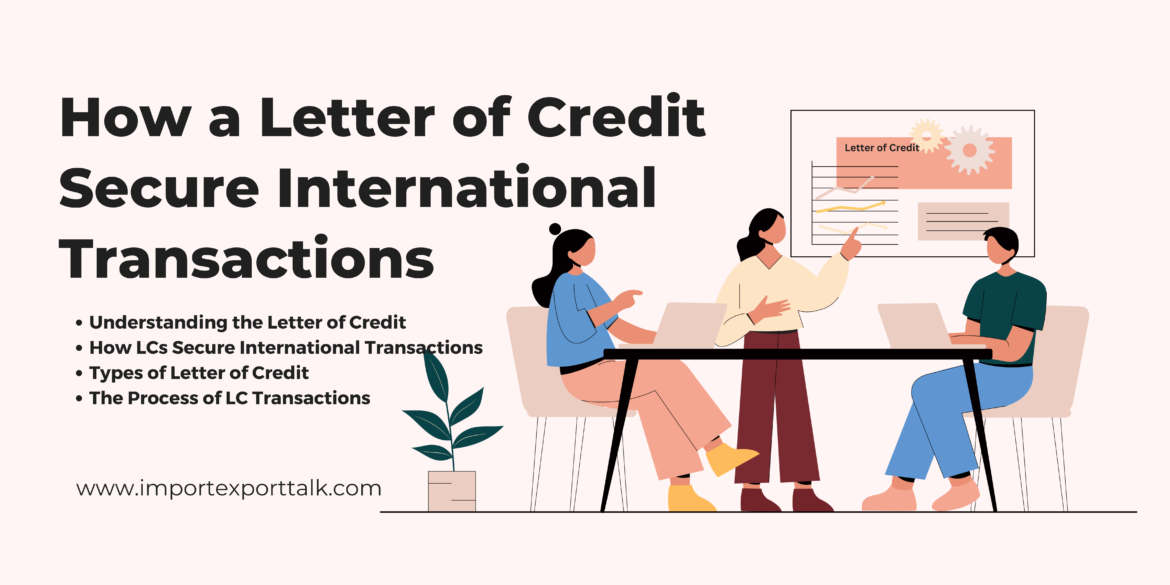In the realm of international trade, where distances are vast and risks are real, the assurance of secure transactions is paramount. One instrument that stands as a pillar of trust in global commerce is the Letter of Credit (LC). This financial tool provides a safety net, ensuring that exporters receive payment and importers receive goods as per the agreed terms. The world of LCs unveils their role in securing international transactions and fostering a climate of confidence between trade partners.
Understanding the Letter of Credit
1. Definition:
A Letter of Credit is a written commitment issued by a bank on behalf of a buyer (importer) to pay a specified amount to the seller (exporter) upon the presentation of specified documents and compliance with the terms of the LC.
2. Role:
An LC acts as a guarantee that the exporter will be paid, and the importer will receive the goods as per the contract. It bridges the gap of trust between parties who might not have a well-established business relationship.
How LCs Secure International Transactions
1. Payment Assurance:
One of the primary ways LCs secure international transactions is by providing payment assurance to exporters. When an LC is established, the buyer’s bank guarantees to make the payment to the exporter as long as the exporter fulfills the terms and conditions set out in the LC. This assurance mitigates the risk of non-payment, a concern that often arises when dealing with unknown or distant buyers.
2. Compliance with Contract Terms:
LCs also play a critical role in ensuring that both parties adhere to the terms of the trade agreement. The exporter is required to provide specific documents, such as bills of lading, commercial invoices, and certificates of origin, that demonstrate compliance with the terms stipulated in the LC. This document review process ensures that the goods are shipped as agreed and meet the buyer’s specifications.
3. Intermediary Role of Banks:
The involvement of banks as intermediaries in the LC process adds an extra layer of security. The buyer’s bank, known as the issuing bank, stands as a guarantor for the payment. The seller’s bank, known as the advising or confirming bank (if applicable), verifies the documents presented by the exporter and facilitates the release of funds. This dual-bank mechanism ensures that the payment is contingent upon the successful fulfillment of the trade agreement.
In essence, LCs create a structured and regulated framework that ensures mutual trust between the parties involved in an international transaction. By establishing clear terms, conditions, and verification procedures, LCs provide a standardized way to secure trade, regardless of the geographical distances or potential uncertainties involved.
Whether it’s a multimillion-dollar shipment of machinery or a smaller consignment of goods, the security provided by LCs remains a cornerstone of international trade. With the assurance of payment and compliance, trade participants can confidently engage in cross-border transactions, fostering healthy business relationships and contributing to the growth of the global economy.
Different Types of LCs
1. Revolving LC:
A Revolving LC is particularly useful for businesses engaged in recurring transactions. This type of LC involves a predetermined credit limit that is reinstated after each utilization. It’s ideal for scenarios where ongoing trade relationships require a continuous flow of goods and payments.
2. Standby LC:
A Standby LC operates as a secondary form of payment assurance. It acts as a safety net for the seller in case the buyer defaults on payment. While the primary purpose of an LC is to facilitate trade, a standby LC is more akin to a financial guarantee, ensuring that obligations are fulfilled even if the primary payment method fails.
3. Transferable LC:
A Transferable LC allows the exporter to transfer part or all of their rights under the LC to another party. This type of LC is especially advantageous when the exporter is acting as an intermediary or middleman in the supply chain. By transferring their rights, the exporter can involve third parties to fulfill the terms of the LC.
4. Back-to-Back LC:
A Back-to-Back LC is a complex arrangement involving two separate LCs. In this scenario, the exporter receives an LC from the buyer and uses it as collateral to request a second LC to purchase the necessary goods from a supplier. This type of LC is often employed when the exporter lacks the goods in stock and needs to source them from another supplier.
5. Red Clause LC:
A Red Clause LC includes a clause that allows the advising or confirming bank to make an advance payment to the beneficiary (exporter) before the presentation of documents. This can be useful when the exporter requires funds upfront to cover production or procurement costs.
6. Green Clause LC:
Similar to a Red Clause LC, a Green Clause LC goes a step further by allowing for the storage of goods in a warehouse specified in the LC. This can be beneficial when the exporter needs to store the goods for an extended period before shipment.
7. Sight LC vs. Usance LC:
An LC can also be categorized based on the payment terms. In a Sight LC, payment is made upon the presentation of compliant documents. In contrast, a Usance LC allows for deferred payment, where payment is made at a future specified date after the presentation of documents.
Each type of LC serves a distinct purpose and addresses specific trade scenarios. By offering a range of options, LCs provide trade participants with the flexibility to tailor their financial arrangements to match their unique business needs, further enhancing the efficiency and security of international transactions.
The Process of LC Transactions
1. Issuance of LC:
The LC transaction begins with the issuance of the Letter of Credit by the buyer’s bank, known as the issuing bank. This bank issues the LC upon the buyer’s request and in accordance with the terms agreed upon between the buyer and the seller. The LC outlines the conditions that must be met for the payment to be made to the seller.
2. Presentation of Documents:
Once the exporter ships the goods as per the terms of the trade agreement, they begin the process of presenting the required documents to their bank, also known as the advising bank. These documents typically include the bill of lading, commercial invoice, certificate of origin, and other relevant documents specified in the LC.
3. Document Verification:
The advising bank carefully reviews the presented documents to ensure they comply with the terms and conditions stipulated in the LC. The bank verifies that the documents are accurate, complete, and match the requirements outlined in the LC.
4. Dispatch to Buyer’s Bank:
Once the advising bank is satisfied with the documents’ compliance, it forwards them to the buyer’s bank (issuing bank) for further review. The buyer’s bank conducts its own examination of the documents to confirm their accuracy and conformity with the LC terms.
5. Payment or Acceptance:
Upon verification of the documents, the buyer’s bank proceeds with either the payment to the seller or the acceptance of drafts (if the LC terms involve deferred payment). The payment or acceptance is contingent upon the successful fulfillment of the conditions set out in the LC.
6. Reimbursement to Seller’s Bank:
Following the payment or acceptance, the buyer’s bank reimburses the seller’s bank (advising bank) for the amount paid to the seller. This step involves the financial settlement between the buyer’s and seller’s banks, ensuring that the funds are transferred as per the terms of the LC.
7. Goods Shipment and Delivery:
With the payment or acceptance secured, the seller proceeds to release the goods for shipment to the buyer. The seller ensures that the goods are delivered as per the terms of the trade agreement, completing their part of the transaction.
8. Receipt of Goods by Buyer:
Upon receiving the goods, the buyer inspects them to ensure they meet the agreed specifications and are in satisfactory condition. This step confirms the successful completion of the trade transaction.
In the intricate tapestry of global trade, where oceans separate partners and currencies fluctuate, the Letter of Credit stands as a beacon of trust and assurance. It exemplifies how financial instruments can transcend geographical boundaries and facilitate secure international transactions.
As exporters and importers forge new connections and explore new markets, the Letter of Credit remains a steadfast companion, embodying the essence of trade assurance. With each LC transaction, a promise is fulfilled, goods change hands, and the world of commerce continues to thrive on the foundation of trust.


2 comments
finance experts provide guidance on choosing the most suitable payment method, whether it’s a letter of credit, open account, or other
ARSPJ 8811F IEC want your guidance. 9527508613 Dk pharma impex pvt Ltd lnl